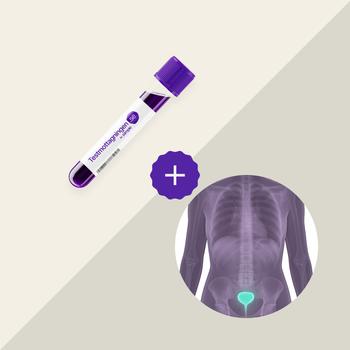Stockholm3 PSA test with risk assessment
Unlike traditional PSA tests, which only measure the levels of prostate-specific antigen, Stockholm3 uses an advanced algorithm to analyze a wider set of data.
Stockholm3 is a combination of biomarkers in blood samples (total PSA, free PSA, hK2, MSMB, MIC1 and 101 genetic markers) and anamnestic data: age, previous prostate biopsy and heredity for prostate cancer.
This makes it possible to detect more cancer cases requiring treatment and reduce the number of unnecessary biopsies. Stockholm3 is used for prostate cancer screening and offers a more reliable method for early detection and treatment.
Based on data from over 75,000 men, the results from Stockholm3 have been published in prestigious scientific journals such as The Lancet Oncology and European Urology.
Components of the Stockholm3 test
- Biomarkers: Stockholm3 analyzes several protein markers, including PSA, hK2, MSMB and MIC-1.
- Genetic markers: Analysis of genetic variants linked to an increased risk of prostate cancer.
- Clinical data: Factors such as age, family history of prostate cancer and previous biopsy results are included.
- Algorithm: An advanced algorithm compiles data from biomarkers, genetic markers and clinical factors to provide an individual risk score.
Stockholm3 Risk Score
The result of the Stockholm3 test is a Risk Score that indicates the risk of prostate cancer requiring treatment. The test also provides a recommendation for continued treatment based on the risk assessment.
Advantages of Stockholm3 compared to the PSA test
- Higher precision: Stockholm3 finds twice as many cancer cases requiring treatment compared to the PSA test in clinical routine.
- Reduced overdiagnosis: The test effectively distinguishes between treatment-requiring and indolent (harmless) cancer, reducing the number of unnecessary biopsies by 50 percent.
- Early detection: Early detection of prostate cancer requiring treatment improves the chances of successful treatment and can save lives.
Reduced side effects
As Stockholm3 reduces the number of unnecessary biopsies, the risk of side effects such as sepsis, blood in urine and stool, which are common complications of prostate biopsies, is also reduced. This means that many men do not have to undergo unnecessary and potentially harmful interventions.
Use in clinical practice
- Screening: Stockholm3 can be used for general screening of men over the age of 50 to identify those who have a higher risk of prostate cancer requiring treatment.
- Follow-up: For men with previously elevated PSA levels or those who have already been treated for prostate cancer, Stockholm3 can provide more detailed information as a basis for follow-up and treatment decisions.
Summary of Stockholm3 analysis
The analysis of Stockholm3 is carried out in several different steps:
- Analysis for total PSA: First, the level of total PSA in the blood is measured.
- Additional analyses: If total PSA is ≥ 1.5 ng/ml, additional proteins and genetic changes are analyzed.
- Calculation of results: Based on the results of these analyzes and clinical data, the following is calculated:
- Stockholm3 Risk Score
- Stockholm3 Prostate Volume cut-off
- Stockholm3 Recommendation






















